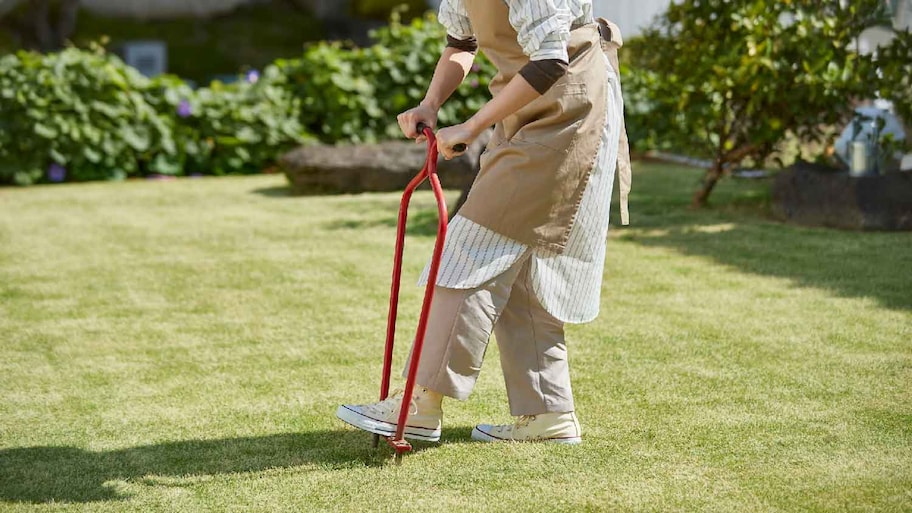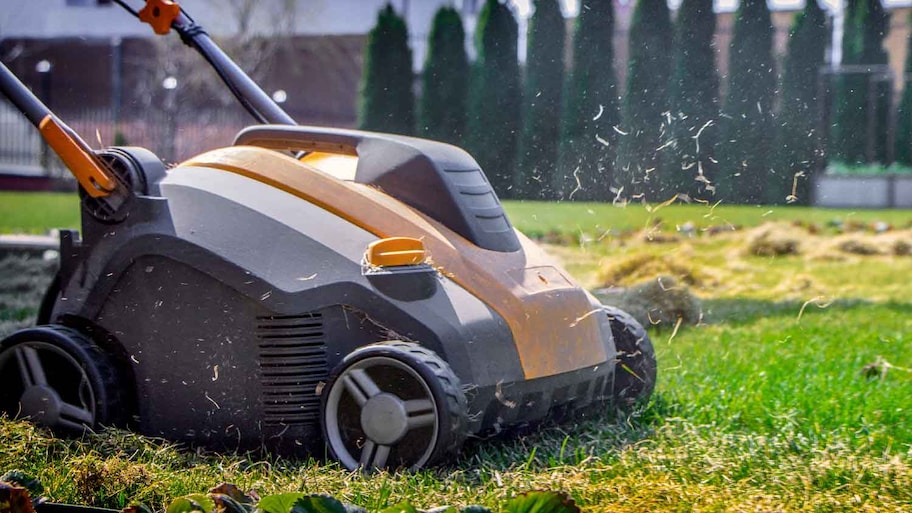What Is Core Aeration? Is It the Right Method for Your Lawn?
Give your lawn some room to breathe—and grow


Highlights
Core aeration is the most effective type of lawn aeration.
It extracts plugs of soil from your yard with a machine or pitchfork-like tool.
The purpose of core aeration is to bring air, water, and nutrients to your grass’s roots.
Core aeration is the best aeration method if your soil is heavily compacted.
However, it’s more expensive and messier than spike aeration.
Aeration is kind of a lawn care superhero, alleviating all sorts of frustrating lawn problems, like slow-growing grass, tough soil, and soggy patches in your yard. While there are several ways to aerate your yard, core aeration is the most effective—as well as the best for large lawns or heavily compacted soil. So, what is core aeration for lawns, and how does it work? Let’s walk through it.
What Is Core Aeration and How Does It Work?
As a form of lawn aeration, core aeration (also known as plug aeration) punches holes in your yard, creating pathways for oxygen, water, and nutrients to reach the grass’s roots and improving root and grass growth. It’s best for compacted, heavy clay soil and yards that get a lot of foot traffic.
There are a few kinds of lawn core aeration tools (more on that below), but they all work similarly. They have hollow tines that penetrate the ground, removing cylindrical-shaped cores (aka plugs) of soil throughout your yard to reach your roots.
What’s the Difference Between Core Aeration and Spike Aeration?
Spike aeration is another popular type of lawn aeration, but it has some notable differences from core aeration. For starters, spike aeration tools have solid tines—instead of hollow ones—that poke smaller holes in your lawn rather than extracting plugs of soil from the ground. Spike aeration doesn’t penetrate your soil as effectively as core aeration, meaning less air, water, and nutrients will reach your roots.
Also, spike aeration is a short-term solution that’s best for moderately compacted loose or sandy soil. Core aeration, on the other hand, can work on heavily compacted soil and has more long-term benefits for your lawn.
In terms of price, spike aeration is slightly less expensive than core aeration. On average, it costs between $40 and $250 to have a professional spike aerate your lawn (compared to core aeration’s $75 to $250 range).
Lawn Core Aeration Methods and Costs

If you decide to core aerate your lawn yourself, you’ll need to decide which type of tool to use for the job. There are a few options to consider depending on your budget, the size of your yard, and how much manual labor you’re willing to put in.
Manual Core Aerators
On the more affordable end, manual core aerators are pitchfork-shaped tools—but instead of spiky tines, they have a set of hollow tines that are about 1/2 inch to 3/4 inch in diameter. Since they require some serious elbow grease, they’re best for small lawns.
With a manual core aerator, you’ll have to walk around your yard and push the aerator into the ground with your foot, leaving about 3 inches of space between each hole. You can buy one of these devices for $50 or less from online retailers or hardware stores.
Gas-Powered Core Aerators
Gas-powered aerators look like heavy-duty lawnmowers, with the aeration mechanism at the front and a handle and wheels in the back. To use one, you’ll push it across your yard in one direction, then repeat the process in the perpendicular direction to perform what’s known as double core aeration.
You can rent gas-powered core aerators from hardware stores, usually in half-day or full-day intervals. On average, the cost of aerating your lawn with a rented gas-powered aerator is about $65 for four hours or $100 per day, along with a $150 deposit.
Tow-Behind/Pull-Behind Core Aerators
If you have a riding mower or tractor and a lot of ground to cover, you might opt for a tow-behind core aerator. As the name would suggest, these machines connect to the back of your mower or tractor, aerating your grass as you drive around.
Most residential tow-behind core aerators cost around $250 to $400. You can also rent them for under $75 per day plus a deposit.
Core Aeration Pros and Cons

Not sure whether core aeration is right for your lawn? Consider these pros and cons.
Pros
It offers a long-term solution to break up compacted soil and promote grass and root growth.
It reduces thatch buildup.
It works for more soil types than spike aeration.
Soil plugs add nutrients to your lawn as they decompose.
Cons
It’s often pricier than spike aeration.
Some people don’t like the look of left-behind soil plugs in their yard.
It can be hard work if you do it yourself using a manual core aerator.
Renting a gas-powered or tow-behind core aerator can be a hassle.
DIY vs. Hiring a Pro
Many home improvement tasks are more affordable if you do them yourself, but lawn aeration usually isn't one of them. For one, there's quite a bit of hard work involved—even if you use an aeration machine rather than a manual aerator. Plus, borrowing an aerator can be inconvenient and add hours to your project time. So, considering the time, effort, and rental costs involved, you might find that it makes more sense to hire a local lawn aeration professional for this job.
Frequently Asked Questions
Experts typically recommend aerating your lawn about once per year, but your aeration frequency will depend on your soil type, lawn condition, and other factors. For instance, you should aerate annually if you have clay-heavy soil or frequent foot traffic in your backyard. However, if your soil is loose or sandy and you don't use your yard often, you can probably aerate every other year.
When it comes to aerating versus dethatching, one isn’t necessarily better than the other because they each have their own purpose. If you have compacted soil (whether from a lot of sun or people walking on it), it may need core aeration. Your lawn might need dethatching if it has at least 1/2 inches of thatch (a mix of grass, leaves, roots, and other living and dead plant material).
To prepare your lawn for core aeration, water it the day before you aerate. (Alternatively, you can wait until it rains and aerate the following day.) Aerating after watering or a rainy day will make the process easier since you can penetrate moist soil better than dry soil. You should also flag your sprinklers so that you don’t accidentally hit them while aerating. If you have a lot of thatch buildup in your yard, you might need to dethatch your lawn before aerating as well.
